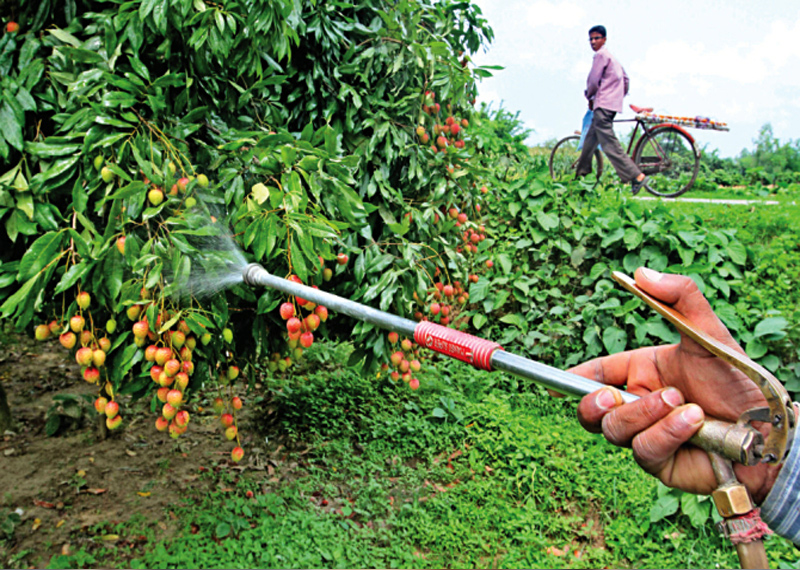
The concept
In recent years, the plant protection scenario in most parts of the developed and developing countries have undergone dramatic changes. The emphasis has shifted from the hitherto dominant chemical pesticides to integrated pest management (IPM) where the focus is on reduced reliance on chemical pesticides. Such a change has become imminent mainly because of the increasing failures of chemical pesticides in controlling crop pests and diseases, and ever-increasing global awareness.
Numerous pest species and mites have shown various degrees of resistance and human illness. Pesticides, once thought to be a panacea for all pest problems, are viewed with suspicion today. However, it may not be too late to correct the mistakes and use of pesticide judiciously; this is exactly what IPM advocates for.
Pests and diseases cannot be controlled by relying on any single method – be it chemical, cultural, mechanical, biological, regulatory or any other. It may be necessary to combine more than one method; such realisation gave birth to the concept of IPM. It is a combination and coordination of experience and intelligence. Farmers Field School (FFS), Diversity Field School (DFS), Plant Clinics, Integrated Plant Nutrient Management (IPNs) and Nepal Good Agriculture Practice (NGAP) are synergistically working within the frame of IPM in Nepal.
What does the IPM mean?
Integrated pest management (IPM) is an ecosystem-based strategy that focuses on long-term prevention of pests that in the context of the associated environment and the population dynamics of the pest species, utilises all suitable techniques and methods in as compatible manner as possible and maintains the pest population below those causing economic injury. The IPM emphasises growing healthy crop with the least possible disruption to agro-ecosystems and encourages natural pest control by empowering the farmers. It is the combination of experiences and intelligence; hence is an intelligent pest management approach which can be simplified as the use of discretion at every stage of the agricultural operation.
This approach uses pesticides judiciously. It also accords the highest priority to biological control and other eco-friendly methods and uses chemicals only as a last resort. The natural enemies are the enemies of our enemies; hence they need multiplying naturally and in an argumentative way, which the IPM teaches. It tries to control the pest at every stage of its life-cycle, i.e. eggs, larva, pupa and at the adult stage. For the IPM approach to be successful, coordination between agronomists, plant breeders, pathologists, entomologists, extension workers, policy makers and above all, farmers is necessary.
What does the IPM seek?
In fact, the IPM flags about the potential hazards of the chemical pesticides, thereby promoting the use of nonchemical methods whenever possible. In this approach, pesticides are viewed as poisons, not medicines. Careful selection, dose preparation, application and adoption of the working period are taught. Always, consideration is given to minimise the risk of pesticides to human health and/or environmental risks. It empowers farmers, staff and concerned stakeholders by educating and engaging them in the novel pest management practice. It identifies the opportunities to explore alternative controls that will lessen the use of chemical treatments.
Similarly, it promotes the responsible application to reduce non-targeted adverse effects on organisms, agricultural fields and water system and the development of improved notification system for the use of chemicals. It identifies and explores the interventions for mass production of bio-rational compounds as an alternative to chemical based production system. In the IPM mode, a review and documentation of the best practices that fit under the IPM framework are done. It supports the improvement of air and water quality and biodiversity (pollinators and soil ecosystem).
How does the IPM work?
The IPM is not a blind approach for pest management. Its recommendations emanate from the scientific knowledge about the concerned crop, bioecology of its pests and their natural enemies, economic and social compulsions. In the IPM, growers need the following approach and components.
- Prevention by managing ecosystem: With the IPM, farmers can take actions to keep pests from becoming a problem, such as by growing a healthy crop that can withstand pest attacks, using disease-resistant plants or habitat manipulation. The IPNs and cultural practices are effective means.
- Knowing foes before taking action: Correctly identifying the pest is a key to knowing whether a pest is likely to become a problem and determining the best management strategy. Regular scouting, plant clinics and FFS, DFS are some of the effective means.
- Establishing monitoring guidelines: A routine monitoring of both pests and natural enemies is an important part of the IPM. Methods of monitoring include visual inspection, light traps, insect sex pheromones and various forms of traps, sweep nets, etc.
- Establishing action threshold for the pest: Providing thoughtful, informed advice and access to technology decide whether the pest can be tolerated or whether it is a problem that warrants control. It is based on the pest population level that produces damage equal to the cost of preventing damage by controlling the pest. Plant clinics, mobile clinics, and pest scouting, and field monitoring are useful in establishing the threshold level.
- Biological control: It is the use of natural enemies—predators, parasitoides, pathogens, and competitors—to control pests and their damage. Use of Trichogramma, Chrysoperla, Metarhizium, Beauveria, Trichoderma are some of the bio-control agents used in Nepal.
- Cultural control: Practices that reduce pest establishment, reproduction, dispersal, and survival can be used. For example, changing irrigation practices, crop rotation, mix cropping, strip farming, pest prevention plantation practices (P4 practices) are some established measures in this component.
- Mechanical and physical control: With these measures, the pest is killed directly or indirectly by attracting or blocking out, or making the environment unsuitable for it. Insect sex pheromone traps, lures and trap crops (marigold, chickpea, etc) have shown greater effectiveness against ranges of pests. Poly house, agri-nets serve as mechanical barriers against pest insect. Mulches and soil solarisation are effective against weeds and diseases.
- Chemical control: In the IPM, pesticides are used only as a last resort when needed and in combination with other control methods.
- Combine management for greater effectiveness: A range of technologies can be considered for use in the IPM so that the tactic is most effective, economical, and simple and has the least impact on non-target species and environment.
- Monitoring, evaluation and documentation of the results: This allows one to make adjustments to improve the effectiveness of future pest management strategies. Reports, documentaries, IPM fairs and various forms of the agro fair are found effective in Nepal.
The way forward
The IPM provides thoughtful, informed advice and access to technology by which the farmers can enhance and sustain the production. Sensible choice requires good knowledge and expertise being available to farmers and their advisors. It gives emphasis to varietal selection. A large number of conventional host plants have shown various degrees of tolerance and resistance against ranges of diseases and insect pests. Their selection and introduction through breeding is apparent.
A safe choice of chemicals should be a priority in Nepal. In some circumstances, early prophylactic chemical treatment such as seed treatment may be useful to reduce the number of later season sprays. Enhanced priorities should be given on biological control agents and bio-rational approach. Mass release of pest predators or parasitoids or microbial pesticides may be an effective and alternative option to chemical pesticides. Biorational control using botanicals and, augmented and inundated release of insect pathogenic fungi such as Metarhizium and Beauveria have demonstrated ample possibilities of controlling numerous pests.
Agro advisory services through call centres, plant clinics and audiovisual kits appear effective, which should be promoted without delay in Nepal. Finally, public policy should be supportive. The government of Nepal and provincial governments have accorded high priority to the IPM in their long-term policies and plans. Regulations are amended in the Pesticide Act and Food Safety Act. The IPM, hence, seems one of the gateways to the organic production system in Nepal.
The author is Secretary at the Ministry of Agriculture and Livestock Development.



 GC is Secretary at the Ministry of Agriculture and Livestock Development.
GC is Secretary at the Ministry of Agriculture and Livestock Development.














